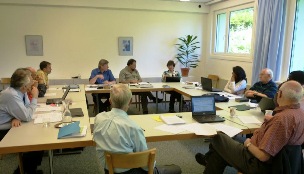The world leadership of the Seventh-day Adventists has issued a highly unusual “appeal for unity” to regional administrative units of the church that have either taken or are considering independent action regarding the ordination of women to gospel ministry. The request comes in a statement issued on June 29 in response to actions by several union conferences, including two in North America.
The union conferences, the key constituent elements of the church’s worldwide General Conference (GC), have indicated either a willingness to ordain women, or to take independent actions that would permit such ordinations in their territories. At present, the Seventh-day Adventist Church does not ordain women to ministry, following votes at General Conference sessions in 1990 and 1995 on the question where the issue was a major focus of the international delegation.
The appeal was prepared and unanimously accepted by consensus by the General Conference officers, a group of 40 senior leaders of the church, including the 13 division presidents who also serve as vice-presidents of the General Conference.
The appeal begins by noting the recent local actions and/or proposals, as well as reminding both the union conferences and the church’s wider membership that the entire subject of ordination is under study by the worldwide Adventist family, with results due in 2014. Once those results are received, the document states, the G.C.’s Executive Committee, the highest interim authority between quinquennial international sessions of the church, will decide whether to make further recommendations on the ordination issue to the 60th General Conference Session in San Antonio, Texas, in July 2015.
Until then, a move “to change or modify ordination practices is a global one and necessitates a decision from the world body,” the document stated.
“For any union to introduce a different ministerial ordination practice is seen, by the rest of the Church, as readiness to set aside a world Church decision and proceed in another direction,” Adventist leaders wrote. “Such actions, taken at the very time when the world Church is engaged in a study and discussion of the matter, pre-empt the process and any decision that might come from it.”
The leaders pointed to the collaborative approach to key decisions that has characterized Seventh-day Adventist polity since the church’s organization nearly 150 years ago in 1863: “The essence of unity in Seventh-day Adventist organizational functioning is the mutual commitment of all organizations to collective decision-making in matters affecting the whole family—and the acceptance of those decisions as the authority of the Church. The action of any union in pursuing a different course of action represents a rejection of this key value in denominational life.”
At the same time, the appeal noted, “General Conference officers welcome and invite unions to participate in the global study of ordination. This study will be the most widespread and thorough study the Church has undertaken on this topic. Earlier studies have been conducted by commissions. This is the first time that a study of ministerial ordination engages the whole Church through the 13 divisions.”
The leaders acknowledge that the question of women’s ordination has been a topic of deep concern to many within the movement: “… We realize that sharply differing convictions with respect to ministerial ordination for women exist in our global family. We also realize that the passage of time without finding satisfaction for the tensions on this question can give rise to frustration and the erosion of confidence that a timely and mutually satisfactory resolution can be found.”
However, the Adventist world leaders said they “earnestly appeal” to the unions involved to:
1. Operate in harmony with the decisions of the worldwide church;
2. Avoid any independent action contrary to the decisions taken by the global body of the church in 1990 and 1995;
3. Communicate to their constituents the implications of independent action for the health of the wider denomination;
4. Actively engage in the established global discussion about the practice of ordination slated to report in 2014 and 2015.
As of December 31, 2010, the Seventh-day Adventist Church had 60 unions with conference status and 59 unions with mission status. Organized as a General Conference in 1863, the Seventh-day Adventist Church has 17 million baptized members and is active in 209 countries and territories around the world. An estimated 30 million people attend Seventh-day Adventist worship services weekly.

